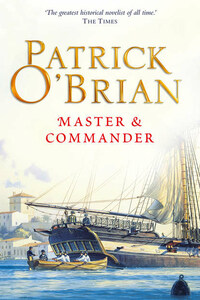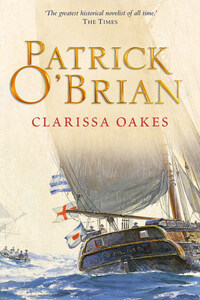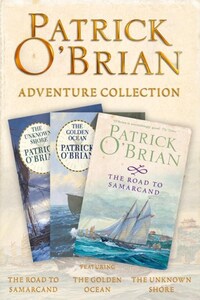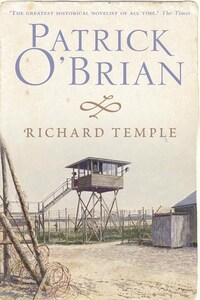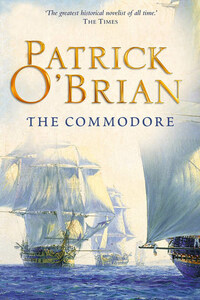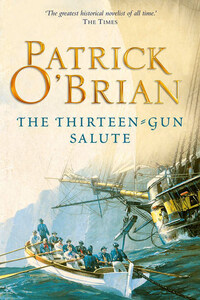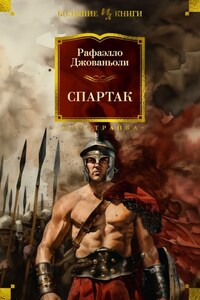PATRICK OâBRIAN
Master and Commander
Copyright
This novel is entirely a work of fiction. The names, characters and incidents portrayed in it are the work of the authorâs imagination. Any resemblance to actual persons, living or dead, events or localities is entirely coincidental.
Harper
An imprint of HarperCollinsPublishers Ltd. 1 London Bridge Street London SE1 9GF
www.harpercollins.co.uk
First Published in Great Britain by Collins 1970
Copyright © Patrick OâBrian 1970
Patrick OâBrian asserts the moral right to be identified as the author of this work
All rights reserved under International and Pan-American Copyright Conventions. By payment of the required fees, you have been granted the non-exclusive, non-transferable right to access and read the text of this ebook on-screen. No part of this text may be reproduced, transmitted, down-loaded, decompiled, reverse engineered, or stored in or introduced into any information storage and retrieval system, in any form or by any means, whether electronic or mechanical, now known or hereinafter invented, without the express written permission of HarperCollins ebooks
HarperCollinsPublishers has made every reasonable effort to ensure that any picture content and written content in this ebook has been included or removed in accordance with the contractual and technological constraints in operation at the time of publication
Source ISBN: 9780006499152
Ebook Edition © DECEMBER 2011 ISBN: 9780007429288 Version: 2017-03-09
Dedication
MARIAE LEMBI NOSTRI DUCI ET MAGISTRAE DO DEDICO
Diagram of a Square-Rigged Ship
The sails of a square-rigged ship, hung out to dry in a calm.
1 Flying jib
2 Jib
3 Fore topmast staysail
4 Fore staysail
5 Foresail, or course
6 Fore topsail
7 Fore topgallant
8 Mainstaysail
9 Main topmast staysail
10 Middle staysail
11 Main topgallant staysail
12 Mainsail, or course
13 Maintopsail
14 Main topgallant
15 Mizzen staysail
16 Mizzen topmast staysail
17 Mizzen topgallant staysail
18 Mizzen sail
19 Spanker
20 Mizzen topsail
21 Mizzen topgallant
Illustration source: Serres, Liber Nauticus.
Courtesy of The Science and Technology Research Center, The New York Public Library, Astor, Lenox, and Tilden Foundation
Authorâs Note
When one is writing about the Royal Navy of the eighteenth and early nineteenth centuries it is difficult to avoid understatement; it is difficult to do full justice to oneâs subject; for so very often the improbable reality outruns fiction. Even an uncommonly warm and industrious imagination could scarcely produce the frail shape of Commodore Nelson leaping from his battered seventy-four-gun Captain through the quarter-gallery window of the eighty-gun San Nicolas, taking her, and hurrying on across her deck to board the towering San Josef of a hundred and twelve guns, so that âon the deck of a Spanish first-rate, extravagant as the story may seem, did I receive the swords of the vanquished Spaniards; which, as I received, I gave to William Fearney, one of my bargemen, who put them, with the greatest sang-froid, under his armâ.
The pages of Beatson, James and the Naval Chronicle, the Admiralty papers in the Public Record Office, the biographies in Marshall and OâByrne are filled with actions that may be a little less spectacular (there was only one Nelson), but that are certainly no less spirited â actions that few men could invent and perhaps none present with total conviction. That is why I have gone straight to the source for the fighting in this book. From the great wealth of brilliantly-fought, baldly-described actions I have picked some I particularly admire; and so when I describe a fight I have log-books, official letters, contemporary accounts or the participantsâ own memoirs to vouch for every exchange. Yet, on the other hand, I have not felt slavishly bound to precise chronological sequence; and the naval historian will notice, for example, that Sir James Saumarezâ action in the Gut of Gibraltar has been postponed until after the grape-harvest, just as he will see that at least one of my Sophieâs battles was fought by quite another sloop, though one of exactly the same strength. Indeed, I have taken great liberties; I have seized upon documents, poems, letters; in short, jâai pris mon bien là où je lâai trouvé, and within a context of general historical accuracy I have changed names, places and minor events to suit my tale.
My point is that the admirable men of those times, the Cochranes, Byrons, Falconers, Seymours, Boscawens and the many less famous sailors from whom I have in some degree compounded my characters, are best celebrated in their own splendid actions rather than in imaginary contests; that authenticity is a jewel; and that the echo of their words has an abiding value.
